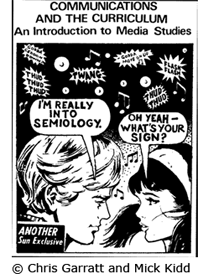Theoretical Context for Barthes’s Theories of the Text
Semiotics
 Semiotics is the study of the way signs behave within society. Signs operate within various systems of communication between people. The science was conceived by Swiss linguist Ferdinand de Saussure in Paris at the turn of the twentieth century. Saussure’s theory is organized around two sets of binary oppositions:
Semiotics is the study of the way signs behave within society. Signs operate within various systems of communication between people. The science was conceived by Swiss linguist Ferdinand de Saussure in Paris at the turn of the twentieth century. Saussure’s theory is organized around two sets of binary oppositions:
- language and speech
- image (signifier) and concept (signified)
The importance of signs and signification has been recognized throughout much of the history of both philosophy and psychology. Plato and Aristotle both explored the relationship between signs and the world, and Augustine considered the nature of the sign within a conventional system. These theories have had a lasting effect on Western philosophy, especially through Scholastic philosophy. More recently, Umberto Eco, in his “Semiotics and Philosophy of Language” (1984) has argued that semiotic theories are implicit in the work of most, perhaps all, major thinkers.
Saussure argues that language, although the most important, is just one of the systems of signs that enable human beings to communicate with one another. Other systems of communication include sign language, social conventions, and symbolic rituals.
All sign systems are essentially arbitrary. That is, there is no rational connection between a physical object (signified) and the word or symbol attributed to it (signifier). The green light at an intersection associated with the action “go” could equally be purple or blue. There is nothing inherent about the colour green that makes it an appropriate symbol to indicate that it is safe to move ahead.
Barthes & Semiotics
Roland Barthes further develops the theory of the arbitrary nature of signs, drawing from the philosophical pool of such theorists as Marx, Freud, Sartre, Levi-Strauss, Foucault, Derrida, Philippe, Sollers, and Kristeva. In his work, Barthes focuses on the artificial nature of all communication systems.
Barthes believes that a dividing line between reality and the symbols used to represent it extends to many cultural forms (photographs, film, advertising, music, etc.). He attacks these modern cultural forms because they blur this dividing line between the real and the artificial. For example, a photograph is not merely a captured moment, but rather it is endowed with structural meaning that is culturally significant. In much the same way, a sporting event can be seen as a ritualistic expression of social and cultural values.
Structuralism
The theory of structuralism forms the basis of semiology. It originates from the Saussurian idea that modern linguistics is made up of structures. English, for example, is a complete structure for the expression and communication of thoughts. Structuralism uses language as a model for the study of other human symbolic systems. Knowledge is structured by and through conventions made up of signs and signifying practices. This knowledge is derived from the connections between ‘reality,’ the social, the individual, and the subconscious.
The linguistic sign is best understood by a synchronic analysis — logical and psychological relations that bind together coexisting terms and form a system in the collective mind of the speakers. In contrast, diachronic linguistics study relations that bind together successive terms not perceived by the collective mind but substituted for each other without forming a system (Ungar, xiv).
Central to this last concept is what Barthes identifies in S/Z (1957) as the Five Codes. These codes, deemed necessary when reading a text, give signs a context. In other words, they allow insight into the multiple layering of ideological meaning present within text.









